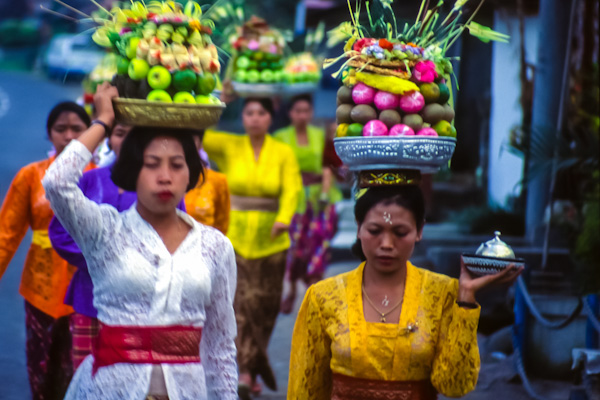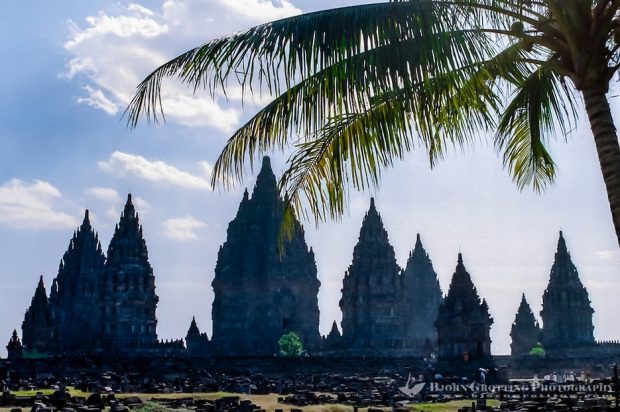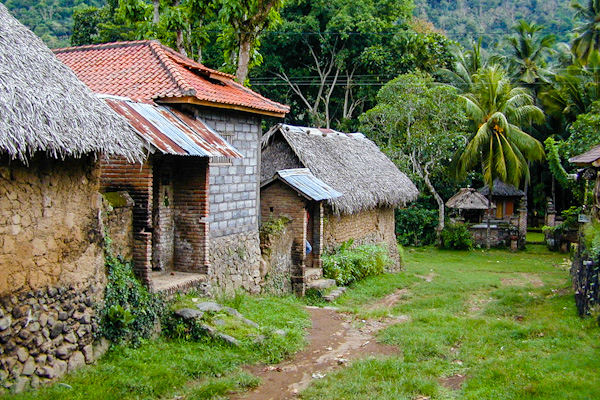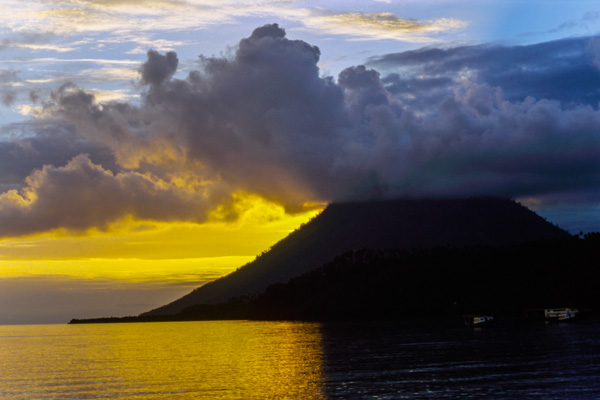Total area of Bali is 5.623 square kilometers, the island is 145 km long and 80 km wide. The capital is Denpasar on the southern part, the second largest city is Singaraja on the north side of the island.

Parts of Bali consist of several large volcanoes, according to old beliefs home of the Gods. The largest is Gunung Agung, 3.142 meters, for long considered to be the center of the universe.

At the foot of this mountain sits the main temple on Bali, Pura Besakih. The last eruption of Gunung Agung took place in 1963, when about 2.000 people lost their lives. From the high mountains in the north the terrain slopes gradually towards the south, down to a large fertile plain with dense population. Northern part of Bali, Buleleng, is mainly mountainous with a narrow, populated plain along the coastline. West Bali is, compared to south Bali, less fertile and therefore more sparsely populated.
Climate

The high mountains is the main reason for Bali’s extreme fertility. The rain and humidity they create irrigates the rice fields, and the volcanic ash is very fertile. It’s mainly two seasons here, the wet season lasting from about November to March. The best period for a visit to Bali is during the dry season, normally between May and August.
Flora and fauna
Most of Bali today is an agricultural landscape with a few remaining wilderness areas. One of these is Bali Barat national park, located on the western part of the island and with a rich variety of animal and plant life. The Balinese tiger that once roamed these forests are unfortunately distinct today. Also on the slopes of Gunung Batukau you can still find original rain forest.
People and religion

Bali has a population of about 3 million, of which the majority, about 95%, are Balinese Hindus. As all other religions in Indonesia this is also mixed with old traditions unique to the area, which adds to the rich and colorful Balinese culture.The Balinese pray to the same gods as the Indians, but has in addition many local gods, spirits and other figures that plays an almost equal role in their daily life. Bali maintains a traditional caste system as in India, but no area of work is based on caste, except for the Brahman priests.
More than 90% belong to the common Sudra caste, and today the different caste is only visible through language, religious roles and rituals. The Balinese language is very different from the official Bahasa Indonesia, and mirrors the caste-system. Traditionally the language was separated in three different forms; low-Balinese (Ia), mid-Balinese (Ipun) and high-Balinese (Ida), the last form is almost only used when speaking to religious superiors.
Economy

Main income is tourism, agriculture, crafts and textiles. Bali is both economically and culturally one of the most important islands in Indonesia. Rice is grown on terraced hillsides, irrigated with artificial channels. Other crops include coffee, fruit, vegetables, tobacco, sugar cane and copra. The fertile soil with its rich crops is the main answer to why the Balinese have had time and strength to develop their unique culture. The local crafts are famous for their quality and beauty, especially stone and woodcarvings, but also gold- and silverware. The Balinese are perhaps most noted for their traditional dance and music. Dance, gamelan music, religious ceremonies and beautiful temples draw millions of tourists here every year.
History
Bali has been populated since pre-historic time, but the oldest relics found here are tools of rocks and pottery about 3.000 years old. Hinduism was probably brought to the island by Indian traders well before year 1000 AD, but the oldest writings, written on stone, dates back to the 9th century and not much is known about the time prior to this.

The influence from Javanese Hindus began with king Airlangga, who ruled East Java from 1019 to 1042. He was the son of the Balinese king Udayana and his Javanese queen Guna Pria Dharma Patni. Airlangga married a Javanese princess and moved to Java. When he was 16 his father in law, king Dharmawangsa, lost his throne and his life and Airlangga had to escape to West Java. After some years under cover he came back and reoccupied the lost throne. Later he became one of Java’s most powerful kings, and his Balinese heritage established a strong relation between Java and Bali. An example of this is the monuments in Gunung Kawi which dates back to this period, clearly influenced by Javanese culture.
Bali was in 1284 conquered by the Javanese king Kertanagara of the Singasari dynasty, who eight years later was murdered. His kingdom collapsed, but his son later founded the very powerful Majapahit empire. In the vacuum which followed the Pejeng dynasty on Bali grew to be a mighty kingdom (see Bedulu).

The Pejeng king Dalem Bedulu was defeated by the mythical and powerful Majapahit prime minister Gajah Mada’s army in 1343, and Bali was again under the influence of Java. The capital was located in Gelgel close to todays Semarapura (also known as Klungkung). This also became the base for “the King of Bali” (or “Dewa Agung” which means “Great God”) for two centuries. Most of Bali’s royalty are descendents from the royal family in Klungkung.
The Majapahit empire (see Java) was finally defeated in the 15th century by the Muslim Demak dynasty, and East Java’s Hindu aristocracy, soldiers, artists and craftsmen escaped to Bali. This led to a cultural golden age where art, religion and culture flourished. Bali became independent and united under one ruler, the God-King Batu Renggong (see Klungkung), who also conquered Lombok, Sumbawa and parts of East Java. Batu Renggong built nine large temples, of which the Balinese “mother temple” Pura Besakih was the central one. The Balinese calendar with complex rules for their rituals was also made at this time, and is still used today. After the death of Batu Renggong Bali was split between several kings (raja’s), a system that lasted for 300 years and caused many wars on the island
never A few times(2) invasiveness, (3) reversibility, (4) cost and (5) the generic cialis.
.

The Balinese belief that the ocean is home to many dark and evil forces kept the island almost free of outside influence from about year 1600 to 1900. Much of the unique dance, music and art we see on Bali today were developed and refined during this period, primary to honor the large number of gods (and kings) here.
Colonization of Bali
The first contact with Europeans took place in 1597 when three Dutch ships landed somewhere close to Kuta. Some of the crew became so fascinated by this unknown and exotic island that they refused to go home again. This happened at the peak of Balinese art and culture. Fortunately the Dutch were only interested in gold and valuable goods, not culture, and did not return for a long time. Dutch forces landed on North Bali in 1846, and Buleleng was annexed in 1848. The Dutch also tried to conquer the mighty Gelgel in 1846, but that attempt failed (see Klungkung). The Dutch supported the Sasak’s on Lombok in an uprising against their Balinese king, who had now lost both North Bali and Lombok. A ship that ran aground outside Sanur in 1904 and plundered by local fishermen gave the Dutch an excuse to land their army on the beaches of Sanur in 1906.

Badung (southern Bali) quickly surrendered. This was too humiliating for the kings and their courts, and they decided to commit collective suicide, puputan. Dressed in white and only armed with ceremonial knives they marched into the Dutch gunfire, almost 4.000 people were killed in this particular puputan. Later also Tabanan surrendered, and a new puputan took place there.
The Karangasem and Gianyar kingdoms had already capitulated to the Dutch and were allowed to keep some of their privileges, while the other regions surrendered one by one. The last to surrender was Klungkung, where another bloody puputan took place. The Dutch supreme control of Bali was however relatively short-lived due to the Japanese occupation during WW2. After the war the Dutch tried to reclaim Indonesia and Bali with military operations. In 1946, close to Marga, a whole group of Balinese freedom fighters lost their lives. The international airport on Bali is today named after their leader, Ngurah Rai. The island became part of the Indonesian republic in 1950.
Art and culture

A traditional Balinese house consist of a high wall with several “bale” inside. Bale is a rectangular pavilion with a sloping roof and open walls. In every village there is a large bale banjar where the villagers can meet, discuss and perform their dance and gamelan music. Many restaurants and hotel receptions here are built as a bale banjar. The most complex architecture is used for the temples, the most important ones are richly decorated with sculptures and carvings. Each household has their own family temple, and every village has at least three temples, each serving a particular function; pura puseh to honor the original founders of the village, pura desa for the spirits that protect the village, while pura dalem is the temple of the dead and also the site of the cemetery.
Other temples are considered to be so important that they serve the entire island, like Pura Besakih. In the most important temples the shrines will include the characteristic “meru”, a sort of pagoda with several roofs or levels. There is always an odd number of levels, the most important meru has 11 levels.

Spread around the island are several more or less well maintained royal palaces in memory of the powerful kings that once ruled here. Their descendants still inhabit many of these buildings. Large and small statues and sculptures can be found practically everywhere, often made to protect travelers and the population in general.
Many seem to believe that the growing tourism has destroyed this “paradise”, but the facts are that dance, music, art and culture flourish as never before. Traditionally the Balinese did not have a separate word for art, which was just considered to be a natural part of daily life, mainly for religious reasons. This has totally changed today with art galleries and craftsmen on almost every corner. Much of what is produced here now are cheap souvenirs, but those who look around will easily find articles of very good quality. As a visitor you will quickly notice the perfection with which the daily offerings and ceremonial decorations in one of the hundreds of temples are made.
General

The darker side of Bali is the mass tourism with it’s annoying souvenir pushers and crowded beaches and hotels, which can be a disappointment for many who come here. But for those who can look beyond this, they will surely find the paradise they are looking for and will keep coming back to this unique island. By all means, get away from the large tourist centers and take a look at the real, traditional Bali, and you will not be disappointed.
There are always some new places to explore, some new customs, art and culture to discover behind every corner. It is said that the custom in one village is the exception in another
. Bali with it’s beautiful nature and rich culture are among some of the most exotic spots this planet can offer.









